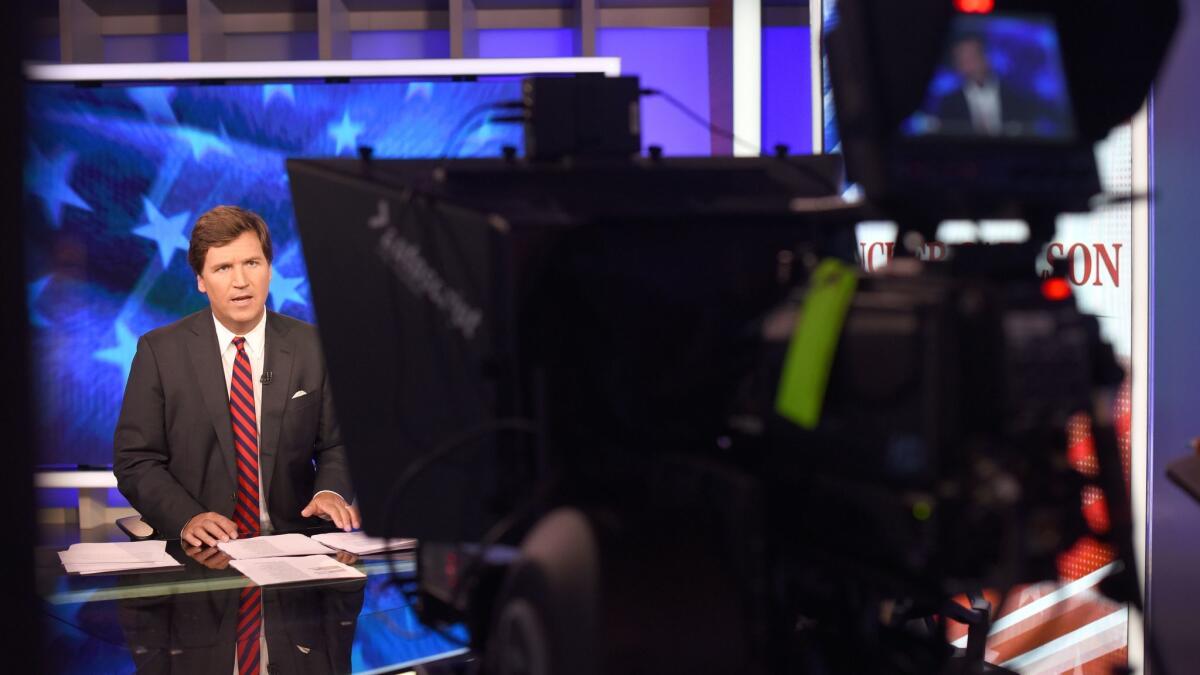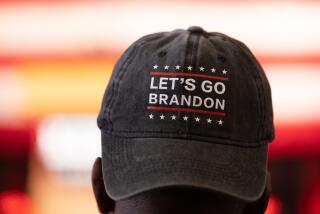Column: The Tucker Carlson advertiser boycott continues, and what’s wrong with that?

A couple of days ago, the Red Lobster restaurant chain announced that it was bailing out on Tucker Carlson’s Fox News TV show, becoming at least the 20th advertiser to pull the plug.
The announcement, and the many that preceded it as the result of an anti-Carlson campaign launched by progressive activists in mid-December, inspired yet another round of hand-wringing about the drawbacks of giving corporations the power to “decide what ideas should be discussed and how they should be discussed.” (The quote comes from Jack Shafer of Politico.)
Other commentators from left and right have fretted about the capacity of such boycotts to suppress free speech, bully innocents and corrode civil society. So let’s put these concerns to rest.
We have a moral obligation to admit the world’s poor, they tell us, even if it makes our country poorer and dirtier and more divided.
— Tucker Carlson
Advertiser boycotts aren’t “corrosive of civil society,” as conservative law professor Jonathan Adler would have it. They don’t limit free speech; they’re an example of free speech in action. They don’t presage a world in which “only milquetoast both-sidesism with a pro-corporate bent will be advertising-supported,” as ace pollster Nate Silver has asserted; indeed, some corporate advertisers have been boycotted out of some of the most pro-business programs on television.
One other thing: They can be effective, as is suggested by the eviction of Bill O’Reilly from the Fox schedule in 2017, after a wholesale flight of advertisers from his previously top-rated show.
They’re especially effective when the boycotts serve to illuminate the affiliations of consumer product companies with noxious programming that most customers may not have been aware of. That brings us to Tucker Carlson.
The boycott of advertisers on his Fox program began in December after he groused on the air about “waves of immigration” of people “with high-school educations or less … Our leaders demand that you shut up and accept this. We have a moral obligation to admit the world’s poor, they tell us, even if it makes our country poorer and dirtier and more divided.”
This was widely interpreted as a racist, or at least flagrantly bigoted, statement. He followed it up with a retrograde observation about the entry of women into high-paid employment, blaming the phenomenon for “men in decline.”
He continued, “In many areas, women suddenly made more than men. Now, before you applaud that as a victory for feminism, consider some of the effects. Study after study has shown that when men make less than women, women generally don’t want to marry them. Now maybe they should want to marry them, but they don’t.”
Carlson, in fact, has become a flag-carrier for the white male, a majority feeling beleaguered because it’s being forced to share its privileges with, you know, others.
Progressive activists at MoveOn.org, Media Matters for America and the social media activist group Sleeping Giants called on Carlson’s advertisers to stop supporting his show, with the implicit call for consumers to boycott advertisers who continued.
The first company reported to bail was the insurer Pacific Life. It was followed, according to Jeremy Barr of the Hollywood Reporter, by Norwegian Cruise Lines, Bowflex, Lexus/Toyota, Samsung, SodaStream, NerdWallet, Just For Men, Jaguar Land Rover and many others. (Barr counts 26 brands in all.) Many of these brands are consumer product companies selling a youth-oriented lifestyle, so it may not be surprising that they’d abandon a show asserting a crotchety, bigoted worldview.
What about the idea that calls to boycott advertisers on a specific show are a threat to open discourse and democracy? The most thorough assertion of this idea was Shafer’s, but his piece is ludicrously off-base.
Shafer argued that crusades against advertisers on certain programs amount to expecting them “to vet my cable news content for me.” He challenged the notion that an advertisement on a show was tantamount to “an automatic endorsement of a program or news article.” He implied that the boycott was the equivalent of censorship, and warned that “advertisers tend to be timid, overreactive, running from controversy and conflict, and in times of perceived crisis, their timidity spreads to publishers, which is bad for journalism.” He raised the threat that the independence of publications such as the Washington Post and New York Times would be jeopardized in the end.
Shafer disclosed that he hates Carlson’s show and wishes it to be consigned to “an immediate, shallow grave in the TV-show boneyard.”
All right, Jack, but what are you going to do about it? Shafer recommended that unhappy viewers “send letters of protest to Fox. Sign petitions protesting his show. Picket Fox headquarters. Cancel your cable TV package. Compose critiques of his show and spread them wide and far. ...Stage a rally! Start a parade!”
Sure. That will work.
Let’s be clear: Boycotts can succeed, because they hit broadcasters in the pocketbook. That’s evident from the tetchy statement Fox News issued after the Carlson boycott began. “We cannot and will not allow voices like Tucker Carlson to be censored by agenda-driven intimidation efforts from the likes of Moveon.org, Media Matters and Sleeping Giants….These same groups never target other broadcasters and operate under a grossly hypocritical double standard given their intolerance to all opposing points of view.”
The most important mistake Shafer makes is conflating general readership publications such as the Post and Times with the extremist commentary on TV, specifically Fox. Notwithstanding the assertions from both left and right that the newspapers tilt the other way, they’re, fundamentally, news-gathering organizations in which it’s virtually impossible to find a political or ideological viewpoint pervasive enough to link with an advertiser. (Editorial and op-ed pages may be an exception, but those tend to balance liberal and conservative commentators, if not necessarily to a degree that satisfies partisans on either side.)
Programs such as Carlson’s and Laura Ingraham’s — to mention a prior target of ad boycotters — espouse a monochromatic viewpoint. Carlson isn’t reporting news, but slathering an ideological spin over it. It’s impossible not to identify an advertiser with his viewpoint, because his show is nothing but viewpoint.
As we observed earlier a propos of Ingraham, companies have been comfortable advertising on these shows for two reasons. One is they covet their viewership, which is among the strongest on Fox.
They other is that they’re confident that customers who are disturbed by the shows’ views won’t even know the companies are advertising on them, because they don’t watch the shows. How many moderates or progressives even knew that Bowflex advertised on Carlson’s show, before its association was threatened with being made public?
The goal of the boycott advocates is to let those customers in on the secret. The advertisers bail, because they know in their souls that Carlson’s and Ingraham’s audiences aren’t big enough to compensate for the loss of customers nauseated by the Fox talkers, once the association becomes broadly known. The flight of some advertisers, especially those hankering for consumers aged 18-34, becomes almost inevitable.
Another mistake Shafer makes is depicting the flight of advertisers from these programs as the equivalent of giving advertisers “the power to decide what ideas should be discussed and how they should be discussed.”
No. It’s consumers who are taking that power in hand. The advertisers are responding to their customers. That’s a sign of people power, not corporate power.
It’s certainly true that consumer boycotts can be wielded against progressive viewpoints as well as conservatives. That happened to Target, which in 2016 was hit with a boycott in the South after a company blog set forth its policy allowing transgender shoppers to use restrooms and fitting rooms corresponding with their gender identities. The policy long had been in place and corresponded to the practice of other major retailers, but publicizing it energized critics during a period in which transgender rights had become a political battlefield. Target sales in the South suffered, but eventually recovered. And the policy remains.
But it’s an error to treat the views of Carlson and Ingraham on the one hand and policies such as Target’s on the other as merely two sides of one coin. They’re not. The first are fundamentally exclusionary and supremacist, and the other is fundamentally inclusive.
Those are important qualitative distinctions. In the U.S., boycotts have been a weapon for groups that have few other ways to get their voices heard, not for dominant cadres preserving their privileges.
And they should be seen as part of the American tradition. Boycotts against British merchants were part of the pressure campaign colonialists waged against the king and Parliament; even after independence, Alexander Hamilton and John Jay launched a boycott against merchants engaged in the slave trade.
Boycotts were an important tool for activists in the civil rights movement, and indeed were given 1st-Amendment protection by the Supreme Court in 1982.
So, sure, those unhappy with Carlson’s brand of exclusionary white male power should keep the boycott threat alive — and they should consider themselves to be operating in the American mainstream.
Keep up to date with Michael Hiltzik. Follow @hiltzikm on Twitter, see his Facebook page, or email [email protected].
Return to Michael Hiltzik’s blog.
More to Read
Inside the business of entertainment
The Wide Shot brings you news, analysis and insights on everything from streaming wars to production — and what it all means for the future.
You may occasionally receive promotional content from the Los Angeles Times.











